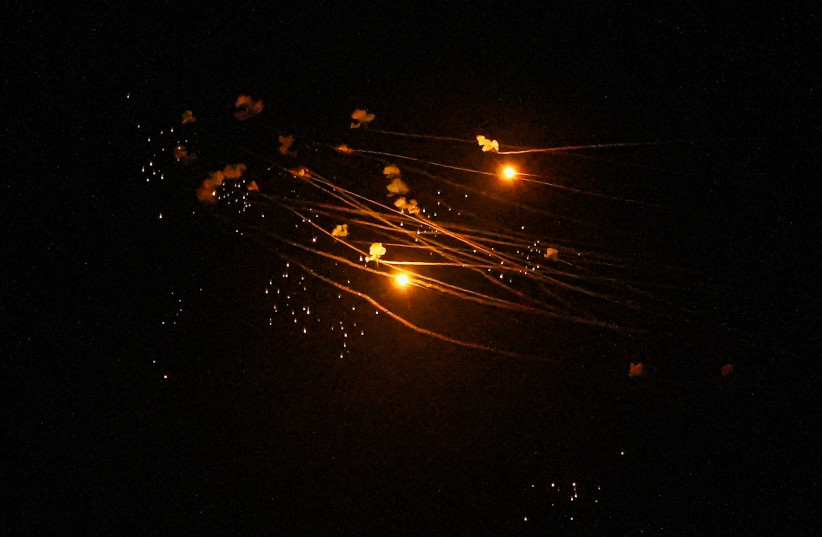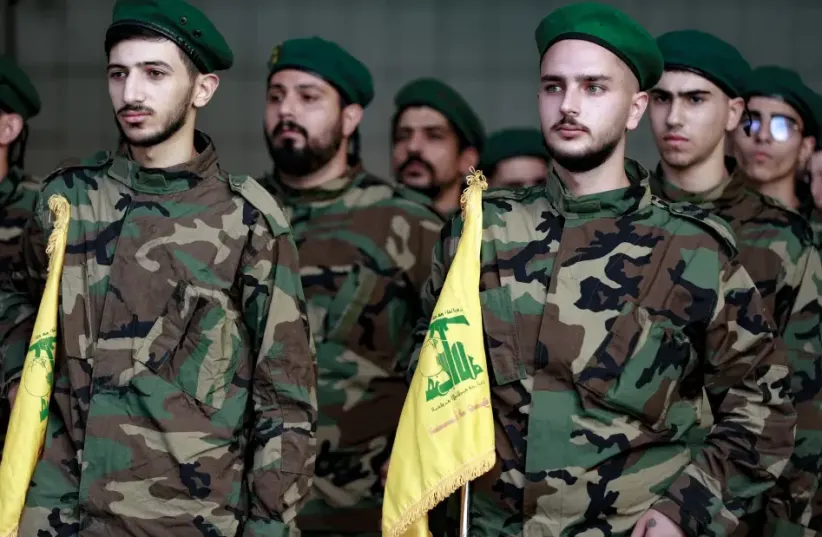On April 14, Iran used 170 advanced drones, 120 ballistic missiles, and 30 cruise missiles to attack Israel.
The speed and explosive power of these threats were all significantly superior to the measly two drones and two antitank missiles with which Hezbollah attacked Israel on Wednesday.
And yet Iran’s 350 advanced attack weapons wounded only one Israeli and Hezbollah’s pinprick attack wounded 18, including 14 soldiers.
How was this possible?
A significant piece of the answer is real estate: Iran’s aerial threats had to travel around 1500 kilometers, whereas Hezbollah’s traveled around three kilometers.
This meant Israel had far more time to track and destroy Iran’s threats.
Also, because the threats were fired from so far away and there was more time, Israel’s Western allies, plus Jordan, were able to assist in shooting down many threats, with the US alone shooting down around 80.
Iran was also aiming for central strategic air force base locations in Israel’s North and South, which are much better defended than nearly any other parts of Israel.
The small Bedouin city in the North has some air defenses, but nothing comparable. It is mostly focused on Iron Dome defenses against typical low-cost Hezbollah rockets.


In contrast, the IDF has known for several months that Iron Dome and other systems are not made to track or shoot down anti-tank missiles fired from very short ranges which fly in a line-drive trajectory, nor are they necessarily adept at shooting down certain kinds of drones launched from short range/
Although IDF officials after its air force bases were first hit by such attacks months ago said they would adopt new tactics, it seems that these tactics are still having limited success.
Probably one of the tactics is simply clearing most of Hezbollah’s forces out of southern Lebanon.
But if all Hezbollah needs is one or two soldiers at a time who never left, faded in with the civilian population and who find a way to quickly sneak an anti-tank missile out of hiding and fire it off before they are seen, the IDF has its work cut out for it.
Put differently, Hezbollah used lower tech and found a strategically “unimportant” target where soldiers had gotten lax about their security and struck hard and fast at that weak underbelly.
The IDF must come up with a real answer to this threat in the long-run, and possibly before going into a larger war.
If there is one positive, it is that the Hezbollah threat here is itself limited to around five kilometers into Israel because the anti-tank missiles have an eight-kilometer range and Hezbollah fighters usually are firing at least from a couple kilometers back from the border lest they be shot by IDF troops nearby with an old-fashioned visual of them.
Israel is more ready for Iranian weapons precisely because they have a far more devastating potential and could hit anywhere in Israel.
Another major issue with Hezbollah was raised when an IDF official noted that the military has to date now killed six brigade-level Hezbollah commanders to date.
Although the IDF declined to identify all of those commanders at once, the Jerusalem Post has cataloged below all of the senior commanders who the IDF has taken credit for assassinating, starting from an increased focus on such assassinations in January, to provide a picture.
What does six killed brigade commanders mean for Hezbollah?
Hamas has five brigade commanders for about 35,000-40,000 of its forces.
Hezbollah is estimated to have between 50,000-100,000 forces when adding together its various weaker militias as well as its elite Radwan force, which had around 6,000 fighters in southern Lebanon alone at the start of the war in October 2023.
This could translate into 10 or 15 brigade level commanders, with at least one source telling the Jerusalem Post that the number hovers around 15.
However, another source said that Hezbollah is structured differently than Hamas, and that its Radwan forces have their own separate structure from the rest of Hezbollah.
The Post was also told that the specific rank of brigade commander for Hezbollah might be less important than unique individuals who are less replaceable as commanders versus individuals who may have just risen up the ranks over time as a function of seniority and years of service.
But roughly speaking, the IDF has killed a significant number of Hezbollah senior commanders, along with another 30 more junior commanders (if Hamas had 24 battalion commanders, presumably Hezbollah has at least between 50-75), while still not a majority.
The many commanders who have not been hit, including all but one of the central Shura Council (assassinated IRGC commander Mohammad Reza Zahedi is the only member who was killed), are more than capable of maintaining Hezbollah’s moderate constant firing of rockets, anti-tank missiles, and drones on Israel’s North for an indefinite period.
This means that these impressive tactical gains have not slowed Hezbollah much strategically to date.
But that is only if Hezbollah’s sole goal is to maintain moderate fire and pressure on Israel’s North.
In the event of a broader war with Hezbollah, the IDF believes strongly that the loss of so many commanders will greatly reduce Hezbollah’s performance level, including significantly reducing how much fire it can rain down on Israel’s home front in much larger quantities than it is currently doing.
So in the case of war, the killing of so many commanders could have strategic significance, and that fact in and of itself, may eventually get Hezbollah to make a deal.
LIST OF KILLED SENIOR COMMANDERS:
April 16
IDF assassinates two Hezbollah brigade commanders in one day.
April 8:
An Israeli airstrike eliminated Ali Ahmed Hassin, the commander of Hezbollah’s Radwan forces in the Hajir region of southern Lebanon and with the equivalent rank of a brigade commander.
March 31:
The IDF said that the air force had killed senior Hezbollah-Radwan anti-tank missile official Ismail Ali al-Zin. Al-Zin was both a commander and a repository of significant intelligence and operations knowledge for more effective anti-tank missile firing against Israel, having ordered dozens of attacks, the IDF said.
March 29:
The IDF killed Hezbollah’s deputy chief rocket commander Ali Abd Ahasan Naim.
February 26:
The IDF said it had killed senior Hezbollah official Hassan Hussein Salami in an airstrike on southern Lebanon. Salami’s rank is equivalent to that of a brigade commander, was hit on the way to the southern Lebanon village of Majadel. According to the IDF, Salami commanded one of Hezbollah’s regional units, including managing attacks on IDF troops and Israeli communities in northern Israel, especially Kiryat Shmona. Further, it said Salami was involved in directing the Hezbollah attack on the IDF’s base Brigade 769.
February 15:
The IDF assassinated two senior Hezbollah terrorists and a third minor player, including the mastermind of the March 2023 Megiddo terror attack, which stunned the country at the time.
One of those killed by the IDF, senior Hezbollah Radwan commander Ali Muhammad al-Dabas, was the mastermind of that terror plot and also managed significant aspects of the Lebanese terror group's attacks on Israel since October 7.
The second Hezbollah operative killed by the IDF was his deputy Hassan Ibrahim Issa, and the third Hezbollah member's identity was unknown.
February 12:
In Lebanon, an Israeli drone carried out a targeted attack in Bint Jbeil, the IDF said on Monday, with Arab media reports saying that the target was a senior Hezbollah commander. It was unclear whether he survived, but an IDF source later hinted that he did not.
The Saudi Al-Hadith network and Sky News in Arabic both said that the target was Mohammed Alawiya, a senior member of Hezbollah responsible for the Maroun el-Ras region.
February 8:
Senior Hezbollah military commander Abbas al Dabs, known by his nickname Hajj Abdullah, was killed in an alleged Israeli drone strike, Sky News Arabia and other Arab media reported. According to Saudi media al-Hadath, al Dabs coordinated air defense issues with the Islamic Revolutionary Guard Corps, including in Syria. Also, he was said to be in charge of the units which fired on Kiryat Shmona.
January 21:
An unnamed Hezbollah terrorist from the Lebanese organization's VIP and leaders' protection unit was killed in an alleged Israeli drone strike on a vehicle in the village of Kafra in southern Lebanon, local media and Hezbollah confirmed.
Local sources from Al-Arabiya and Al-Hadath first reported that the strike in the village, located some 10 kilometers from the Lebanese border with Israel, failed to kill the main target, who was being secured by Hezbollah.
Arabic media named Fadi Suleiman, a senior Hezbollah field commander, as a key operative who survived the alleged drone strike, though other reports said he might have been killed.
January 9:
IDF Chief Spokesman Brig.-Gen. Daniel Hagari announced on Tuesday that the Israeli Air Force (IAF) killed Hezbollah’s drone chief, Ali Hussein Bergi, earlier in the day. “Ali directed dozens of drone attacks against Israel, and also today he was responsible for an attack in which two drones struck the IDF Northern Command’s base,” said Hagari.
Earlier, it was announced that the IDF also killed three senior members of Hezbollah in a drone attack on a vehicle in southern Lebanon.
Hassan Abeid al-Hussein Ismail, the head of Hezbollah’s drone operations in southern Lebanon, was reportedly responsible for the assaults of hostile UAVs into northern Israeli towns since October 7.
January 8:
The IDF allegedly killed the commander of Hezbollah’s Radwan Force, Wissam al-Tawil.
January 2:
The IDF allegedly killed Hamas Deputy Chief Saleh al-Arouri while he was in Hezbollah territory in Beirut.
